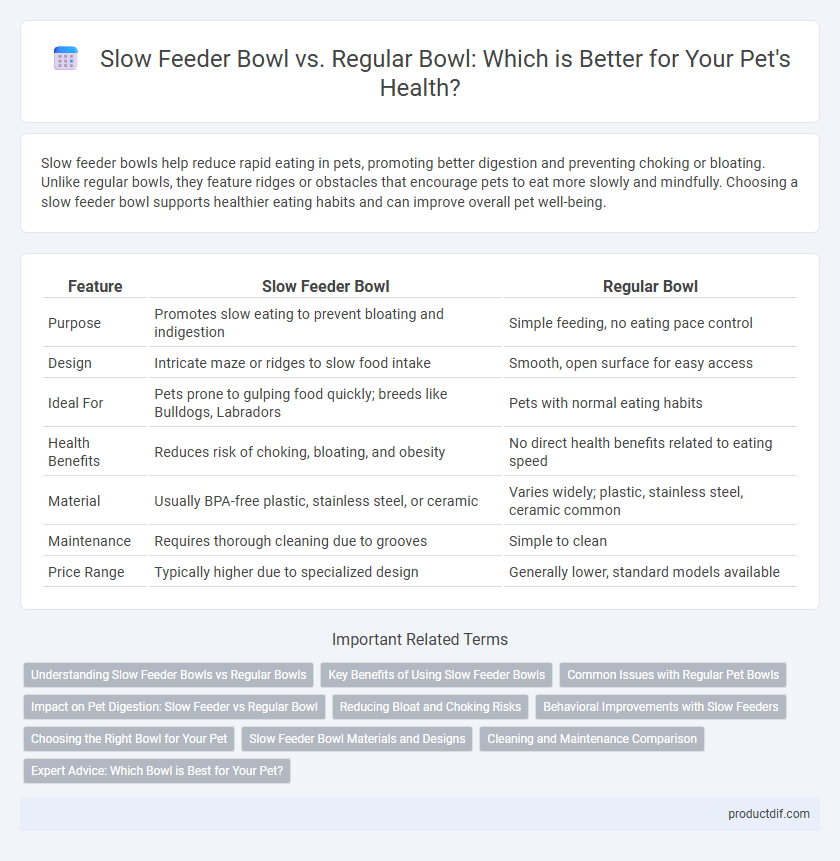Slow feeder bowls help reduce rapid eating in pets, promoting better digestion and preventing choking or bloating. Unlike regular bowls, they feature ridges or obstacles that encourage pets to eat more slowly and mindfully. Choosing a slow feeder bowl supports healthier eating habits and can improve overall pet well-being.
Table of Comparison
| Feature | Slow Feeder Bowl | Regular Bowl |
|---|---|---|
| Purpose | Promotes slow eating to prevent bloating and indigestion | Simple feeding, no eating pace control |
| Design | Intricate maze or ridges to slow food intake | Smooth, open surface for easy access |
| Ideal For | Pets prone to gulping food quickly; breeds like Bulldogs, Labradors | Pets with normal eating habits |
| Health Benefits | Reduces risk of choking, bloating, and obesity | No direct health benefits related to eating speed |
| Material | Usually BPA-free plastic, stainless steel, or ceramic | Varies widely; plastic, stainless steel, ceramic common |
| Maintenance | Requires thorough cleaning due to grooves | Simple to clean |
| Price Range | Typically higher due to specialized design | Generally lower, standard models available |
Understanding Slow Feeder Bowls vs Regular Bowls
Slow feeder bowls are designed with intricate patterns and obstacles that slow down a pet's eating pace, promoting better digestion and reducing risks of bloating and choking, especially in fast eaters. Regular bowls lack these features, allowing pets to consume food quickly, which can lead to overeating and associated health issues. Choosing between slow feeder and regular bowls depends on a pet's eating habits and specific dietary needs for optimal health and well-being.
Key Benefits of Using Slow Feeder Bowls
Slow feeder bowls promote healthier eating habits by preventing pets from gulping down food too quickly, reducing the risk of choking, bloating, and indigestion. These bowls improve digestion and help control portion sizes, contributing to weight management and overall well-being. Made with durable, non-toxic materials, slow feeder bowls are designed to engage pets mentally, providing enrichment during mealtime.
Common Issues with Regular Pet Bowls
Regular pet bowls often contribute to rapid eating, leading to digestive problems such as bloating and choking in pets. These bowls can cause pets to gulp down food too quickly, increasing the risk of obesity and gastrointestinal discomfort. Slow feeder bowls mitigate these issues by promoting slower eating, improving digestion and reducing the likelihood of associated health complications.
Impact on Pet Digestion: Slow Feeder vs Regular Bowl
Slow feeder bowls promote better digestion by preventing pets from eating too quickly, which reduces the risk of bloating, vomiting, and choking. Regular bowls often encourage rapid consumption, leading to indigestion and potential gastrointestinal distress. Choosing a slow feeder bowl can significantly improve digestive health and nutrient absorption in pets.
Reducing Bloat and Choking Risks
Slow feeder bowls significantly reduce bloat and choking risks by controlling the pace at which pets eat, preventing rapid intake of food and air. Regular bowls allow pets to consume large amounts quickly, increasing the likelihood of digestive issues and airway obstruction. Using a slow feeder bowl promotes safer eating habits and improves overall digestive health in pets.
Behavioral Improvements with Slow Feeders
Slow feeder bowls promote healthier eating habits by slowing down a pet's food intake, reducing the risk of gulping and choking. This controlled pace encourages improved digestion and prevents overeating, contributing to better weight management. Behavioral improvements include decreased anxiety during mealtime and less food aggression, fostering a calmer and more enjoyable feeding experience for pets.
Choosing the Right Bowl for Your Pet
Choosing the right bowl for your pet involves considering their eating habits and health needs; slow feeder bowls help prevent gulping and reduce the risk of bloat, especially for fast eaters or pets prone to digestive issues. Regular bowls are suitable for pets that eat slowly and do not have a history of choking or obesity-related problems. Assessing your pet's behavior and consulting with a veterinarian can guide you in selecting the best feeding bowl to promote healthier eating patterns and overall well-being.
Slow Feeder Bowl Materials and Designs
Slow feeder bowls are crafted from durable materials like BPA-free plastic, stainless steel, and silicone, ensuring safety and longevity during mealtime. Their intricate maze-like designs encourage pets to eat slowly, reducing risks of choking and digestion issues, unlike regular bowls with smooth and simple surfaces. These bowls often feature non-slip bases or suction cups, enhancing stability and minimizing spills during feeding.
Cleaning and Maintenance Comparison
Slow feeder bowls feature intricate ridges and patterns designed to slow a pet's eating pace but require more thorough cleaning to remove trapped food particles and prevent bacteria buildup. Regular bowls, typically smooth and simple in design, are easier to clean quickly and often dishwasher-safe, reducing time spent on maintenance. Choosing slow feeder bowls demands consistent attention to hygiene to avoid health issues, whereas regular bowls offer straightforward maintenance with fewer cleaning challenges.
Expert Advice: Which Bowl is Best for Your Pet?
Experts recommend slow feeder bowls for pets prone to overeating or digestive issues, as these bowls promote slower eating and reduce the risk of choking or bloating. Regular bowls suit pets with normal eating habits and no history of digestive problems, providing a simple and easy-to-clean option. Choosing the right bowl depends on your pet's eating behavior, breed, and health requirements, with slow feeder bowls often favored for improving digestion and promoting healthier feeding patterns.
Slow Feeder Bowl vs Regular Bowl Infographic

 productdif.com
productdif.com